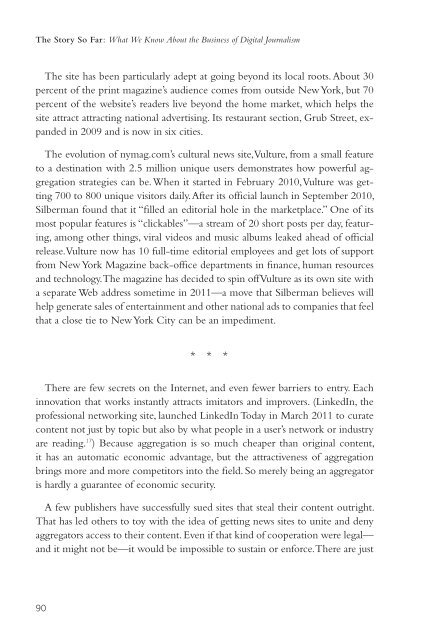What We Know About the Business of Digital Journalism
What We Know About the Business of Digital Journalism
What We Know About the Business of Digital Journalism
You also want an ePaper? Increase the reach of your titles
YUMPU automatically turns print PDFs into web optimized ePapers that Google loves.
The Story So Far: <strong>What</strong> <strong>We</strong> <strong>Know</strong> <strong>About</strong> <strong>the</strong> <strong>Business</strong> <strong>of</strong> <strong>Digital</strong> <strong>Journalism</strong>The site has been particularly adept at going beyond its local roots. <strong>About</strong> 30percent <strong>of</strong> <strong>the</strong> print magazine’s audience comes from outside New York, but 70percent <strong>of</strong> <strong>the</strong> website’s readers live beyond <strong>the</strong> home market, which helps <strong>the</strong>site attract attracting national advertising. Its restaurant section, Grub Street, expandedin 2009 and is now in six cities.The evolution <strong>of</strong> nymag.com’s cultural news site, Vulture, from a small featureto a destination with 2.5 million unique users demonstrates how powerful aggregationstrategies can be. When it started in February 2010, Vulture was getting700 to 800 unique visitors daily. After its <strong>of</strong>ficial launch in September 2010,Silberman found that it “filled an editorial hole in <strong>the</strong> marketplace.” One <strong>of</strong> itsmost popular features is “clickables”—a stream <strong>of</strong> 20 short posts per day, featuring,among o<strong>the</strong>r things, viral videos and music albums leaked ahead <strong>of</strong> <strong>of</strong>ficialrelease. Vulture now has 10 full-time editorial employees and get lots <strong>of</strong> supportfrom New York Magazine back-<strong>of</strong>fice departments in finance, human resourcesand technology. The magazine has decided to spin <strong>of</strong>f Vulture as its own site witha separate <strong>We</strong>b address sometime in 2011—a move that Silberman believes willhelp generate sales <strong>of</strong> entertainment and o<strong>the</strong>r national ads to companies that feelthat a close tie to New York City can be an impediment.* * *There are few secrets on <strong>the</strong> Internet, and even fewer barriers to entry. Eachinnovation that works instantly attracts imitators and improvers. (LinkedIn, <strong>the</strong>pr<strong>of</strong>essional networking site, launched LinkedIn Today in March 2011 to curatecontent not just by topic but also by what people in a user’s network or industryare reading. 17 ) Because aggregation is so much cheaper than original content,it has an automatic economic advantage, but <strong>the</strong> attractiveness <strong>of</strong> aggregationbrings more and more competitors into <strong>the</strong> field. So merely being an aggregatoris hardly a guarantee <strong>of</strong> economic security.A few publishers have successfully sued sites that steal <strong>the</strong>ir content outright.That has led o<strong>the</strong>rs to toy with <strong>the</strong> idea <strong>of</strong> getting news sites to unite and denyaggregators access to <strong>the</strong>ir content. Even if that kind <strong>of</strong> cooperation were legal—and it might not be—it would be impossible to sustain or enforce. There are just90
















